The Satyr Tragopan, scientifically known as Tragopan satyra, is one of the most dazzling members of the pheasant family. Known for its vibrant plumage, unique behaviors, and high-altitude habitats, this bird is a jewel of the Himalayan region. This article provides an in-depth exploration of the Satyr Tragopan’s physical characteristics, habitat, diet, behavior, conservation status, and cultural significance.
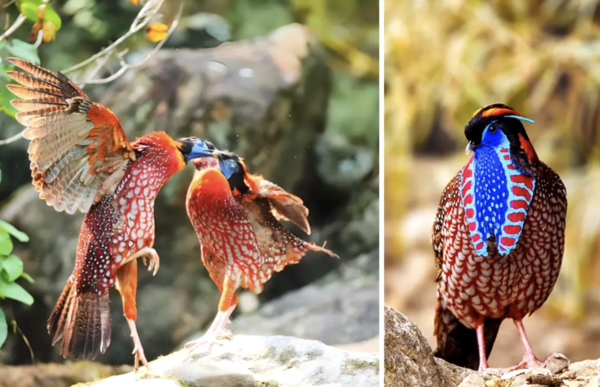
Scientific Name: Tragopan satyra
Common Names: Satyr Tragopan, Crimson Horned Pheasant
Family: Phasianidae
Order: Galliformes
Conservation Status: Near Threatened (IUCN Red List)
The Satyr Tragopan is celebrated for its incredible coloration and unique courtship rituals. Its name “Satyr” originates from Greek mythology, referring to mythical woodland creatures, highlighting the bird’s forest-dwelling nature.
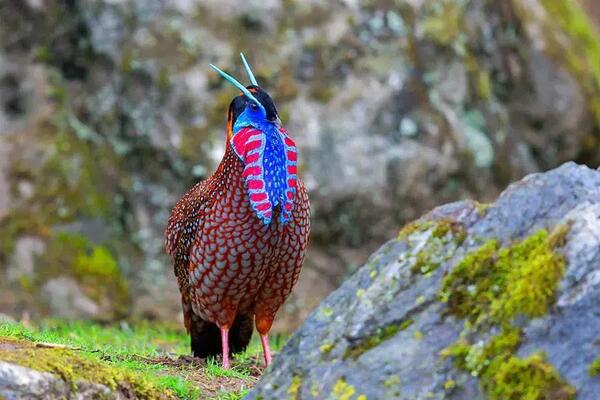
Plumage: The males boast fiery red and orange plumage, speckled with white spots edged in black.
Facial Features: Bright blue facial skin and fleshy, horn-like appendages above the eyes that are displayed during courtship.
Size: Around 68 cm (27 inches) in length; males are larger than females.
Appearance: Subtler brown and buff plumage, which provides excellent camouflage.
Dimorphism: Females are smaller and lack the vivid colors and ornaments of males.
Found in the Himalayan mountain ranges, spanning regions of Bhutan, Nepal, northern India, Tibet, and parts of Myanmar.
Altitude: Prefers elevations between 2,400 to 4,200 meters (7,900 to 13,800 feet).
Environment: Inhabits temperate forests, especially those with dense undergrowth and rhododendron thickets.
The Satyr Tragopan relies on pristine forest ecosystems, making it a key species for monitoring habitat health in the Himalayas.
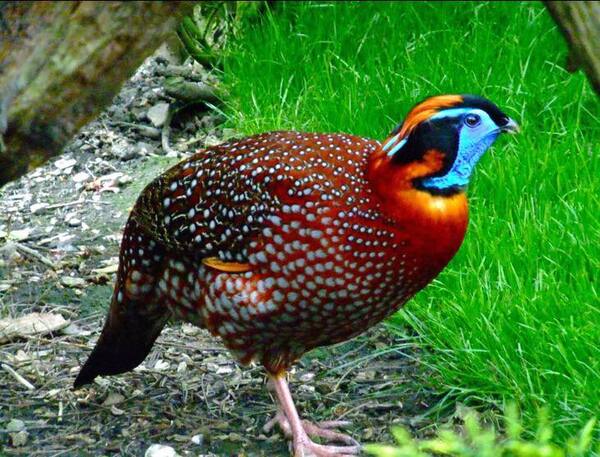
The Satyr Tragopan has a varied diet that includes:
Plants: Leaves, flowers, seeds, and berries.
Insects: Ants, beetles, and other small invertebrates.
Primarily ground feeders, they forage through the forest floor in search of food but will occasionally consume vegetation from shrubs and low trees.
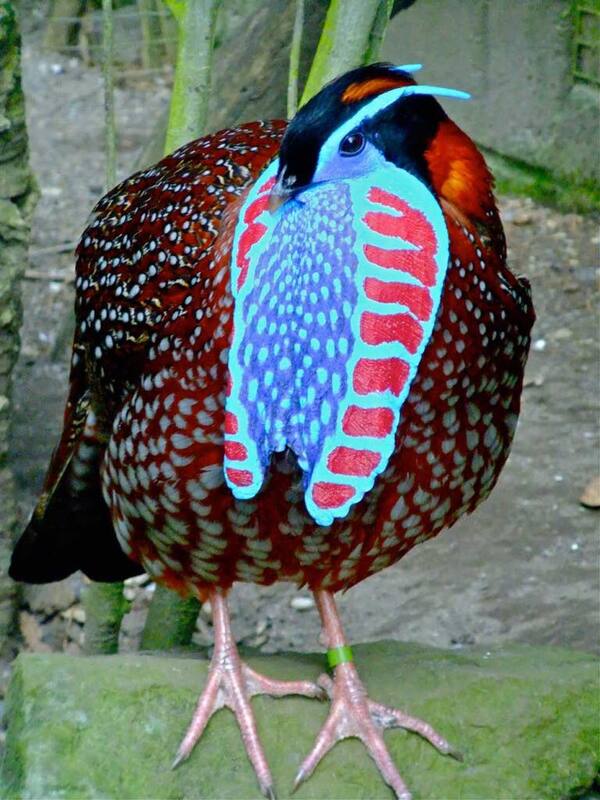
The Satyr Tragopan is renowned for its elaborate courtship displays.
Horns and Bib Display: During the breeding season, the male inflates its blue, fleshy horns and a colorful throat bib, often adorned with intricate patterns.
Dance: Males perform a unique, rhythmic dance to attract females.
Season: Breeding occurs between April and June.
Nests: Females build nests on the ground or in low trees using twigs, leaves, and moss.
Clutch Size: Typically lays 2–4 eggs, which hatch after about 28 days of incubation.
While males are solitary outside the breeding season, females may form small groups with their offspring.
The Satyr Tragopan is classified as Near Threatened due to habitat loss and hunting.
Deforestation: Logging and agricultural expansion reduce their forest habitats.
Hunting: The bird is often targeted for its striking plumage.
Protected Areas: Found in several Himalayan national parks and wildlife sanctuaries.
Community Awareness: Local initiatives to educate communities about sustainable practices.
Symbol of Biodiversity: As a flagship species of the Himalayas, its presence signifies healthy forest ecosystems.
Cultural Value: Revered in some Himalayan communities for its beauty and symbolic importance.
Master of Camouflage: The female’s mottled plumage helps it blend seamlessly into the forest floor, protecting it from predators.
Mythical Namesake: Its name references satyrs from Greek mythology, highlighting its mystical allure.
Cold Adaptation: Thrives in chilly mountain climates, showcasing remarkable adaptability.
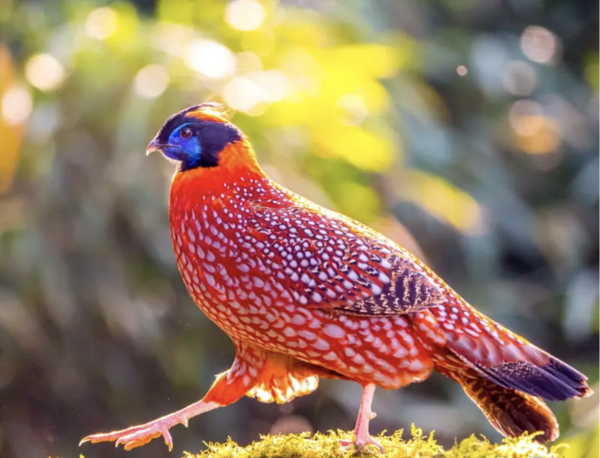
Best Locations:
Bhutan’s Jigme Dorji National Park
Nepal’s Langtang National Park
India’s Kedarnath Wildlife Sanctuary
Season: Spring and early summer offer the best chances to spot this elusive bird during its courtship displays.
Support Conservation Organizations: Donate to or volunteer with organizations like WWF and BirdLife International.
Promote Eco-Tourism: Opt for ethical tourism that respects wildlife habitats.
Spread Awareness: Educate others about the importance of preserving the Himalayan ecosystem.
The Satyr Tragopan is no ordinary bird. Think of it as the "peacock of the mountains," with bright red feathers, blue skin on its face, and quirky "horns" that pop up when it’s showing off. This bird is a mix of beauty and uniqueness, found in the breathtaking Himalayan forests.
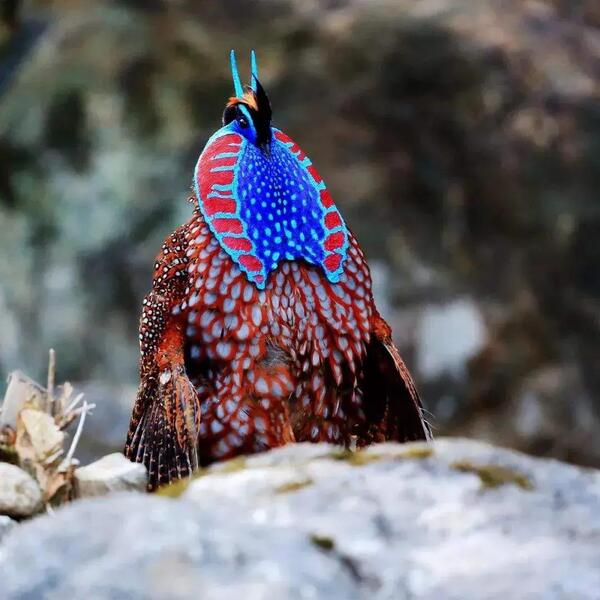
The name is as unique as the bird itself. “Satyr” comes from Greek mythology, referring to woodland creatures known for their playful, magical nature. It’s a fitting name for a bird that looks like it stepped out of a fantasy story. “Tragopan” is a reference to the group of colorful pheasants it belongs to.
Colors that Amaze: The males are decked out in fiery red feathers dotted with white spots, making them look like walking art. The blue face adds an extra splash of wow.
Horn Magic: Males have inflatable blue “horns” above their eyes that they show off during courtship. These aren’t actual horns, but they sure are impressive!
The Bib of Brilliance: When trying to woo a mate, the male reveals a bright, colorful bib under its throat. It’s like a flashy tie for the bird world.
The females are less flashy, with brown and gray feathers that help them hide in the forest. This camouflage is their secret weapon against predators.
The Satyr Tragopan loves the high-altitude Himalayan forests. Think dense, misty woods filled with rhododendron and oak trees. They live in places like:
Bhutan
Nepal
Northern India
Tibet
These birds like it cool and are most comfortable at heights of 2,400 to 4,200 meters (7,900 to 13,800 feet).
The Satyr Tragopan is not a picky eater! They enjoy a mix of:
Plants: Leaves, flowers, and berries from shrubs.
Insects: Ants and beetles for that extra protein.
Seeds: A crunchy favorite.
They spend a lot of time scratching around the forest floor, searching for tasty treats.
Mating season is when the Satyr Tragopan really shines. The males go all out to impress the ladies with their courtship displays. Picture this:
The male inflates its blue horns and puffs out its throat bib, revealing a stunning rainbow of colors.
He then performs a dance, bobbing his head and spreading his feathers.
If the female likes what she sees, she’ll stick around. After mating, the female builds a cozy nest and lays 2–4 eggs. She takes care of the eggs and chicks all by herself.

Unfortunately, the Satyr Tragopan is facing challenges. It’s listed as Near Threatened because of:
Habitat Loss: Logging and farming are shrinking their forest homes.
Hunting: Their colorful feathers make them a target.
Here’s how we can protect this incredible bird:
Support Conservation Efforts: Donate to organizations working to protect Himalayan wildlife.
Choose Eco-Friendly Travel: If you visit the Himalayas, pick eco-tourism options that respect nature.
Spread the Word: Teach others about the Satyr Tragopan and why it’s worth saving.
They are sometimes called the "horned pheasant" because of their unique horns.
The name “Satyr” makes them sound mythical, and they certainly look like they belong in a fairy tale!
Even though males are the show-offs, the females are the true survivors, blending into their surroundings to protect themselves and their young.
This bird isn’t just beautiful—it’s important for the environment. By protecting the Satyr Tragopan, we’re also protecting the forests and all the creatures that live there. It’s a reminder of how amazing and delicate nature can be.
So, the next time you think about the Himalayas, imagine the Satyr Tragopan—a bird as magical and unique as the mountains it calls home.
The Satyr Tragopan is a true marvel of the bird world, with its vibrant colors, intriguing behaviors, and essential role in its ecosystem. Protecting this species is not just about saving a single bird; it’s about preserving the rich biodiversity of the Himalayan forests. By understanding and appreciating its significance, we take a step closer to safeguarding its future.
animal tags: Tragopan-satyra
We created this article in conjunction with AI technology, then made sure it was fact-checked and edited by a Animals Top editor.